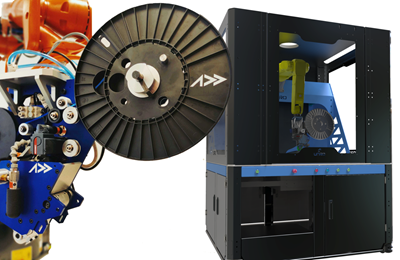Effman installs AFP-XS as part of project to enable AFP for SMEs
uCOMP project with Addcomposites and Quebec partners demonstrates new woven tape and high-permeability preforms for resin infusion in <2 minutes.

Effman installs Addcomposites AFP-XS onto FANUC robot. Photo Credit: Effman.
Effman (Sherbrooke, Quebec, Canada) has integrated and tested the first AFP cell in North America formed by plugging an Addcomposites (Espoo, Finland) AFP head into a FANUC robot. “Until now, AFP has been reserved for major players in the aerospace industries because of the complexity and cost of equipment,” says Yoann Bonnefon, president of Effman. Specializing in the development of automation for composites manufacturing, Effman is now collaborating with Addcomposites to make AFP robotic cells accessible to small and medium enterprises (SMEs).
“The uCOMP project started with the idea of bringing more automation to composites processes,” says Bonnefon. “We see that small companies especially are still relying on manual methods. We want to help them be prepared for the type of industrialization needed in today’s supply chains.” One goal is the ability to produce preforms for processes like vacuum infusion, resin transfer molding (RTM) and Light RTM. “We can improve the process and economics for such preforms,” says Bonnefon.
The AFP-XS provides the key for a light and compact robotic equipment solution that is affordable for small companies with limited financial resources. “This solution also needs to be simple,” adds Bonnefon, “able to be quickly installed and in operation without a lot of expense and training. The AFP-XS has met these needs, weighing less than 20 kilograms and fitting easily within a standard robotic cell. Without any experience with either the AFP-XS head or the ADD PATH software, we were able to complete the installation and, within a few weeks, complete the AFP simulation for parts using a new tape that we developed with a partner in Quebec. This woven glass fiber tape had never before been tested on an AFP-XS head, and yet we were able to use it and make preforms in less than two minutes that were easily processed using resin infusion.”
manufacturing and infusion of preforms
The uCOMP project aims to help SMEs use AFP. This technological advance is being achieved with Effman’s network of Quebec-based partners: , , FANUC America Corp., and Robox. “Our aim is to democratize the use of AFP and composites to make high-performance, affordable small- and medium-size parts,” says Bonnefon.
In addition to thermoset and thermoplastic tapes already used with the AFP-XS, Effman and its partners have developed dry-weave tapes (glass or carbon fiber) allowing the realization of preforms optimized for infusion and injection processes. Effman is now exploring projects with research organizations, to create new structures and new knowledge, but also sees opportunities in the supply chains for sporting goods, as well as automotive and aerospace, as the trends in electrification and new mobility advance. “This equipment is much cheaper than what currently exists in the market, yet enables precise fiber placement to make structural parts,” says Bonnefon. “We see many applications and look forward to working with companies across North America.”
Interested companies can contact and for more details on part and equipment trials.
Related Content
Welding is not bonding
Discussion of the issues in our understanding of thermoplastic composite welded structures and certification of the latest materials and welding technologies for future airframes.
Read MoreInfinite Composites: Type V tanks for space, hydrogen, automotive and more
After a decade of proving its linerless, weight-saving composite tanks with NASA and more than 30 aerospace companies, this CryoSphere pioneer is scaling for growth in commercial space and sustainable transportation on Earth.
Read MoreBladder-assisted compression molding derivative produces complex, autoclave-quality automotive parts
HP Composites’ AirPower technology enables high-rate CFRP roof production with 50% energy savings for the Maserati MC20.
Read MoreCarbon fiber composite pallet revolutionizes freight industry
LOG Point Pallet fuses advanced materials with innovative design and manufacturing to improve supply chains worldwide.
Read MoreRead Next
Addcomposites and Effman partner to provide AFP cells for SMEs
Aim is affordable, enclosed composites manufacturing cells for many different processes (AFP, grinding, buffing, sanding, drilling) in North American market.
Read MoreCeramic matrix composites: Faster, cheaper, higher temperature
New players proliferate, increasing CMC materials and manufacturing capacity, novel processes and automation to meet demand for higher part volumes and performance.
Read MoreScaling up, optimizing the flax fiber composite camper
Greenlander’s Sherpa RV cab, which is largely constructed from flax fiber/bio-epoxy sandwich panels, nears commercial production readiness and next-generation scale-up.
Read More












